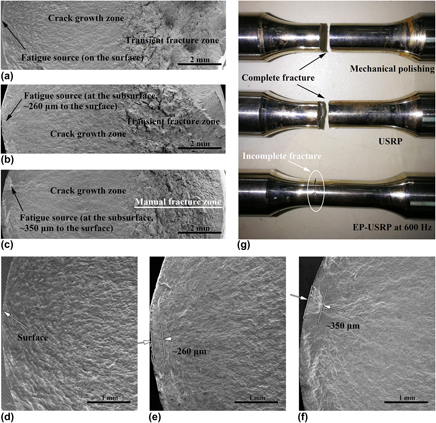Crossref Citations
This article has been cited by the following publications. This list is generated based on data provided by
Crossref.
Wang, Cong
Han, Jing
Zhao, Jiyun
Song, Yuanming
Man, Jiaxiang
Zhu, Hua
Sun, Jiapeng
and
Fang, Liang
2019.
Enhanced Wear Resistance of 316 L Stainless Steel with a Nanostructured Surface Layer Prepared by Ultrasonic Surface Rolling.
Coatings,
Vol. 9,
Issue. 4,
p.
276.
Xu, Guanming
Wang, Chunming
Li, Qiaoli
Zhang, Xuehui
Zhu, Zhiyun
Liang, Tongxiang
and
Yang, Bin
2020.
Effects of ultrasonic rolling on surface performance of 7B85-T6 alloy.
Materials and Manufacturing Processes,
Vol. 35,
Issue. 3,
p.
250.
Wang, Chunming
Xu, Guanming
Zeng, Luming
Tang, Zhenghua
Zhang, Xuehui
and
Liang, Tongxiang
2020.
Enhanced Corrosion Behavior and Mechanical Properties of Al-Zn-Mg-Cu Sheet Alloy by Ultrasonic Surface Rolling Treatment.
Metallurgical and Materials Transactions A,
Vol. 51,
Issue. 5,
p.
1967.
Grimm, Tyler J.
and
Mears, Laine
2021.
Electrically assisted pulse forming using closed-loop force control.
Journal of Manufacturing Processes,
Vol. 71,
Issue. ,
p.
528.
Jerez-Mesa, Ramón
Fargas, Gemma
Roa, Joan Josep
Llumà, Jordi
and
Travieso-Rodriguez, J. Antonio
2021.
Superficial Effects of Ball Burnishing on TRIP Steel AISI 301LN Sheets.
Metals,
Vol. 11,
Issue. 1,
p.
82.
Brasileiro, L.
Sun, Z.
Mabru, C.
Chieragatti, R.
Proust, G.
and
Retraint, D.
2022.
Experimental study of a CoCrMo alloy treated by SMAT under rotating bending fatigue.
Procedia Structural Integrity,
Vol. 38,
Issue. ,
p.
283.
Romero-Resendiz, L.
El-Tahawy, M.
Zhang, T.
Rossi, M.C.
Marulanda-Cardona, D.M.
Yang, T.
Amigó-Borrás, V.
Huang, Y.
Mirzadeh, H.
Beyerlein, I.J.
Huang, J.C.
Langdon, T.G.
and
Zhu, Y.T.
2022.
Heterostructured stainless steel: Properties, current trends, and future perspectives.
Materials Science and Engineering: R: Reports,
Vol. 150,
Issue. ,
p.
100691.
Li, Guangxi
Bie, Wenbo
Zhao, Bo
Chen, Fan
Zhao, Chongyang
and
Zhang, Yuemin
2022.
Ultrasonic assisted machining of gears with enhanced fatigue resistance: A comprehensive review.
Advances in Mechanical Engineering,
Vol. 14,
Issue. 4,
p.
168781322210828.
Ye, Han
Chen, Aimin
Liu, Senzhong
Zhang, Can
Gao, Yunjie
Li, Quan
Lv, Jiawei
Chen, Jie
and
Guo, Hao
2022.
Effect of ultrasonic surface rolling process on the surface properties of QAl10-3-1.5 aluminum bronze alloy.
Surface and Coatings Technology,
Vol. 433,
Issue. ,
p.
128126.
Romero-Resendiz, Liliana
Naeem, Muhammad
and
Zhu, Yuntian Theodore
2023.
Heterostructured Materials by Severe Plastic Deformation: Overview and Perspectives.
MATERIALS TRANSACTIONS,
Vol. 64,
Issue. 10,
p.
2346.
Gao, Menglin
Zeng, Rui
Hu, Junhua
Zhang, Can
Hu, Xing
Xia, Shengjun
Huang, Rongshen
and
Li, Qiulin
2024.
Further enhancement of surface mechanical properties of carburized 9310 steel by electropulsing-assisted ultrasonic surface rolling process.
Surface and Coatings Technology,
Vol. 480,
Issue. ,
p.
130593.
Li, Gang
Hong, Baocun
Song, Da
Ma, Yan
and
Yuan, Chao
2025.
Effect of pulsed current coupled ultrasonic rolling on surface fretting friction and wear properties of Ti-6Al-4V alloy.
Wear,
Vol. 568-569,
Issue. ,
p.
205959.
